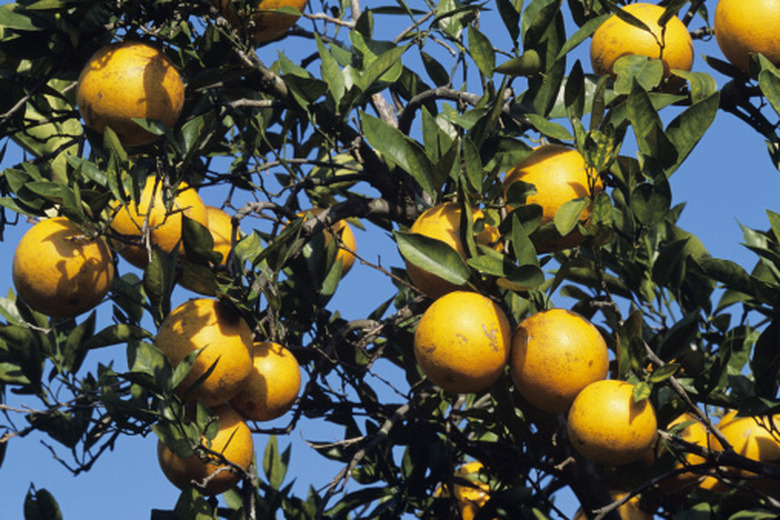Why Does My Orange Tree Have Thorns?
Orange tree stems are frequently armed with thorns, which are most numerous and prominent before trees begin bearing fruit. Thorns, along with spines and prickles, are assumed by many researchers to be a plant-evolved anti-herbivore defense mechanism. Some orange tree cultivars tend to have fewer thorns; even within cultivars, there may be differences in thorniness. In general, orange trees grown from seeds tend to be the thorniest. Alternatively, a tree budded from an adult tree that had few thorns can be virtually thorn-free.
Stage of Life
Many woody plants reproduced from seed, called seedlings, go through an extended juvenile stage that is marked by thorniness and characterized by a lack of blooming. Citrus seedlings tend to exhibit a high degree of growth, erect habits and lots of thorns during this period. This fruit-bearing delay, which may last six or more years, and general thorniness make seed-grown orange trees less desirable than young trees produced from adult tree buds.
- Orange tree stems are frequently armed with thorns, which are most numerous and prominent before trees begin bearing fruit.
- Many woody plants reproduced from seed, called seedlings, go through an extended juvenile stage that is marked by thorniness and characterized by a lack of blooming.
Part of Plant
Orange trees bear slender, blunt-shaped, mildly flexible thorns on twigs. From a botanical standpoint, thorns are short, tapered branches. Branches taper to fine points rather than continue growing like regular branches. Because they are technically branches, thorns are connected to the vascular system of the tree. They have nodes, which are enlarged points where the leaves attach, as well as internodes, which are parts of plant stems between nodes.
Thorn Function
All citrus trees are relatively small-statured evergreen trees or shrubs. The majority of cultivated orange trees are maintained at 15 feet tall or shorter. Limes, which tend to be the shortest citrus tree, also tend to be the thorniest. It has long been assumed by researchers that thorns are this short tree's evolved defense against grazing herbivores. Alternative theorists attribute their presence to heat balance or drought resistance, as thorns are more prevalent in arid regions.
- Orange trees bear slender, blunt-shaped, mildly flexible thorns on twigs.
- It has long been assumed by researchers that thorns are this short tree's evolved defense against grazing herbivores.
Recommendations
You have several options for minimizing the presence or impacts of thorns on orange trees. Thorns may be pruned off. Ideally, they should be removed from root stocks when trees are grafted. In general, mature trees will have fewer thorns than young trees. Fruiting wood will show a reduction in thorns as flower production increases. Protect yourself by vigilantly looking out for thorns, wearing gloves or using a long-handled fruit picker when harvesting oranges.
